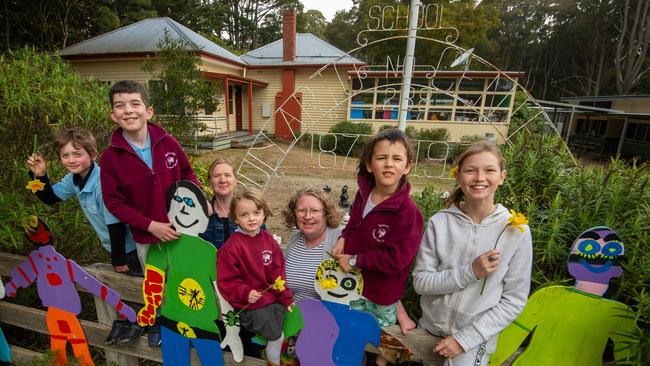Victoria’s best and worst-resourced schools revealed
The schools with the best and worst ratio of teachers to students across Melbourne and the state have been revealed. How does your school fare? THE FULL LIST
Schools Hub
Don't miss out on the headlines from Schools Hub. Followed categories will be added to My News.
The most crowded and well resourced classrooms have been revealed and Victoria rates among the best in Australia for student-to-teacher ratios.
The 10 schools where teachers have the most students to educate have also been unveiled, while the state ranks second nationwide for resources, following the Northern Territory.
An analysis of data from the Australian Curriculum, Assessment and Reporting Authority - to launch the Schools Hub data journalism series on education in Victoria - has found each public, Catholic and independent school’s enrolment and teacher figures.
The figures show Sassafras Primary in the Dandenong Ranges had the largest student cohort, with 22 pupils for every teacher last year.
VCAL program school Hester Hornbrook Academy was next, also with 22 students, then Melbourne’s Ozford College, with 21.
That’s far below the nation’s worst-resourced schools, with Queensland’s Fuluga State school leading the charge with 30.7 pupils, followed by the sunshine state’s Charlotte Mason College with 29.7, then the Northern Territory’s Amanbidji School at 28.3 students.
Meanwhile, Victoria’s smallest student ratio was at the now closed Insight Education Centre for the Blind and Vision Impaired in Berwick, which had six teachers for six students in 2018.
The tiny Ultima Primary, outside Swan Hill, had two teachers for its three students after its enrolments fell from 31 pupils in a decade.
Goongerah Tubbut P-8 College followed, with the Gippsland school having three teachers for five students.
Small rural and regional schools, specialist schools and language campuses were unsurprisingly more likely to be better resourced with a larger number of staff per student.
That included Bullarto Primary, near Daylesford, which ranked among the lowest student-teachers ratios with almost two students per teacher.
They included teaching principal Jo Pegg, who said the small student number — which has grown from four pupils to 11 this year — means they could tailor a child’s education to their interests.
Victoria has an average 13 students for each teacher across all schools in the state, second only to the NT with 12.4.
Western Australia was the least-resourced state, with 14.4 pupils per educator, then NSW with 14.1.
While ratios do not determine the size of the class, they do indicate the resource level of every school.
Not all experts agree that small class sizes make a significant difference in learning, but they do believe that changing teacher — and therefore student — behaviour was critical to improvements in the classroom.
Southern Cross University Adjunct Associate Professor David Zyngier, who was asked to review 112 different class size studies from across the world to provide recommendations to government, said that, in the first years of primary school, small class sizes were critical.
“I would be staying away from any class that has 30 kids in it, anywhere, unless it was a Year 12 class,” Dr Zyngier said.
“We as human beings are evolved to walk and talk all by ourselves, but reading is an artificial task — and to make sense of those squiggles and decode them is a huge leap for little human beings.
“And that is much easier to do in a smaller class than it is to do in a larger class.”
A Department of Education spokeswoman said the department did not regulate student-teacher ratios with principals able to “consider class sizes according to their school’s teaching program”.
“It is important that students are provided with the highest quality learning conditions and that teachers have every opportunity to deliver quality education,” she said.
SMALL SCHOOL LIKE A FAMILY
Small student numbers at Bullarto Primary means it feels “more like a family” than a school.
The tiny campus outside Daylesford had one of the lowest student to teacher ratios last year, with two teachers for four students.
Growing this year to 11 pupils and three teachers, the small school cohort means students can jump in staff cars for excursions, walk to the local library for new books or wander to the nearby creek for classes.

The campus sits in the Wombat State Forest, and while it doesn’t have an oval, it does take children outside to learn for up to half of their class time.
Teaching principal Jo Pegg often gets called ‘mum’, ‘dad’ or even ‘Mémé’, which is French for ‘grandmother’.
“It’s like a family sometimes,” she said.
“I know every child here, I know their siblings, their parents, I know what date they got what animal, I know their interests — there’s literally nothing I don’t know.
“I think the perception in society is small schools can’t provide a well rounded education for kids, but our kids miss out on nothing.”
The school runs a junior class and senior class, and while each year level is given its own specific work, younger children often learned “through osmosis” by being exposed to older students’ lessons.
With 11 children — though currently there’s just six, with five kids away on family holidays — Ms Pegg said it was “very easy to keep track of where the child’s at and keep an eye on any gaps”.
It was also easy to alter the curriculum to reflect students’ interests.
Ms Pegg said one student’s recent fascination with blackberries had her exploring lesson plans on the history of European settlement and introduced species, on horticulture and recipes for blackberry ink, which could be used with quills and in art classes.
“If you really know your curriculum, you can take any child’s interest and make it meet the curriculum.” she said.
COMING TOMORROW
Compare public v private schools, city v regional schools.
